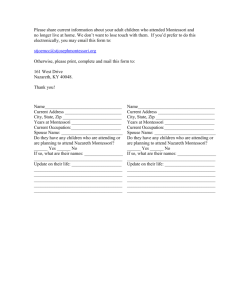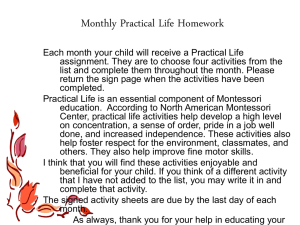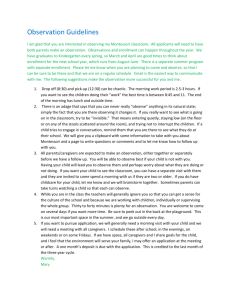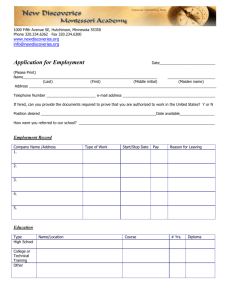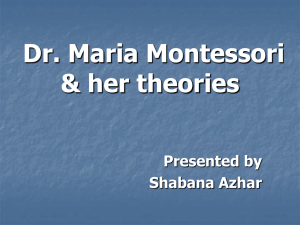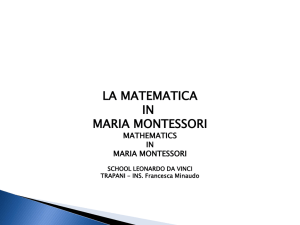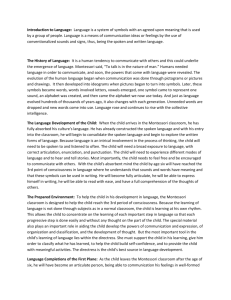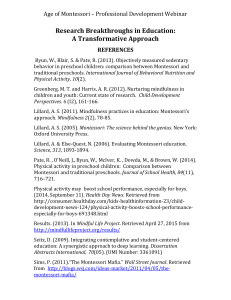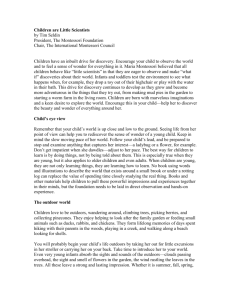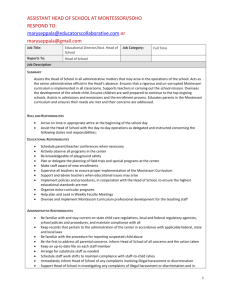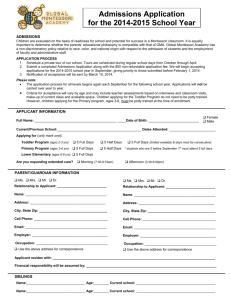Beyond Observation - Utah Montessori Council
advertisement
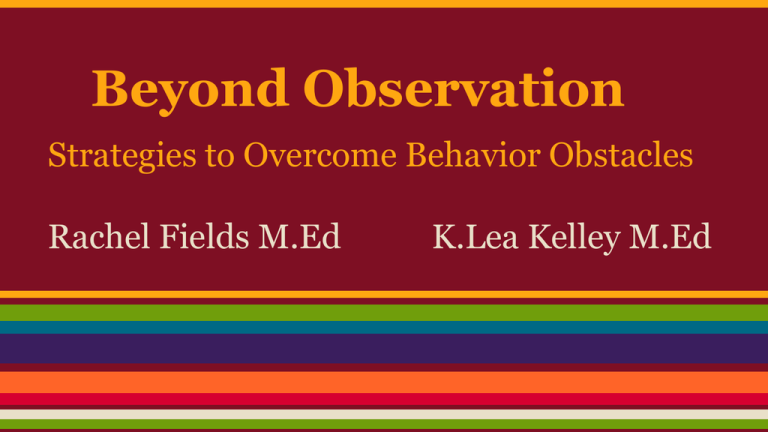
Beyond Observation Strategies to Overcome Behavior Obstacles Rachel Fields M.Ed K.Lea Kelley M.Ed Dr. Montessori’s thoughts “The method of observation is established on one fundamental base- the liberty of the pupils in their spontaneous manifestations.” “But when she (the directress) begins to find it her duty to discern which are the acts to hinder and which are those to observe, the teacher of the old school feels the great void within herself and begins to ask if she will not be inferior to her new task.” The Montessori Method What did Dr. Montessori say? (Said of the teacher in a Montessori classroom) “...she has an exact task to perform, and it is necessary that she should put herself into immediate relation with the truth, by means of rigorous observation, that she should strip off all illusions, all the idle creations of the fancy, that she should distinguish truth from falsehood unerringly, that, in fact, she should follow the example of the scientist, who takes into account of every minute particle of matter...but eliminates all optical delusions, all the confusion which impurities and foreign substances might introduce into the search for truth.” (p138) Montessori, Maria. The Advanced Montessori Method: Spontaneous Activity in Education. Vol. 1. Trans. Florence Simmonds. 1917. Cambridge: Robert Bentley, Inc., 1965. Why observe? ● Follow the child ● Design appropriate interventions or individual programs ● FUBA What is a FuBA? Fu is for functional B is for behavior A is for assessment 4 Functions of Behavior 1. Escape 2. Attention 3. Tangible 4. Sensory What do you see? What is the function of his behavior? http://www.youtube.com/watch?v=vx2JsG 2UcBw Choosing a Target Behavior Be specific ● Rolling on the ground ● Picking nose ● Running in the classroom ● Shouting ● Leaving the classroom ● Meltdown What to observe? Comments often heard: ● “This child is driving me crazy!” ● “I just cannot deal with her.” ● “Why is he so defiant?” Whose problem is it? Ask yourself: ● “Is the child’s behavior your problem?” ● “Is there something in the environment that is causing the behavior?” ● “Is the child’s behavior interfering with their learning and relationships?” Where does the behavior occur? ● ● ● ● ● classroom lunchroom hallway playground pick up and/or drop off ● bathroom ● special class: i.e. Spanish, art, music, PE ● home ● community Maslow’s Hierarchy of Needs When to observe? ALWAYS! Types of Data Qualitative Data ● deals with descriptions ● data can be observed but not measured ● i.e. tired ● Qualitative - Quality Quantitative Data ● deals with numbers ● data can be measured ● i.e. # times leave’s classroom ● Quantitative - Quantity How to Gather Data (Observe) Qualitative Data ● running record ● incidental notes ● child interview ● parent interview ● teacher interview Quantitative Data ● Tape ● 3 x 5 index card ● TOAD ● Peer-to-Peer ● Maria’s Market Strategies Avoidance ● Chunking ● Intermittent Incentives ● Visual Work Chart ● Alternate Works Attention ● Catch ‘em while they're being good ● 15 min. time with teacher/peer ● Allow student to teach a lesson Strategies Tangible ● ● ● ● ● Treasure Box Game on iPad Art Box Books Perler Beads Sensory ● Rice, sand, water, beans ● Heavy Work ● Headphones ● Blanket, yoga mat What to do with information? BIP=Behavior Intervention Program Use information from FuBA to replace unwanted target behavior with incentives that match the function of the behavior (attention, sensory, tangible, avoidance). Labeling the child? The focus is on the behavior NOT the label! Use caution labeling a child. Can be seen as diagnosing a child. Let’s wrap it up! ● ● ● ● ● ● ● Choose target behavior Gather more qualitative data Determine function of behavior Implement strategy Write a BIP Continue gathering data Change strategy if needed
